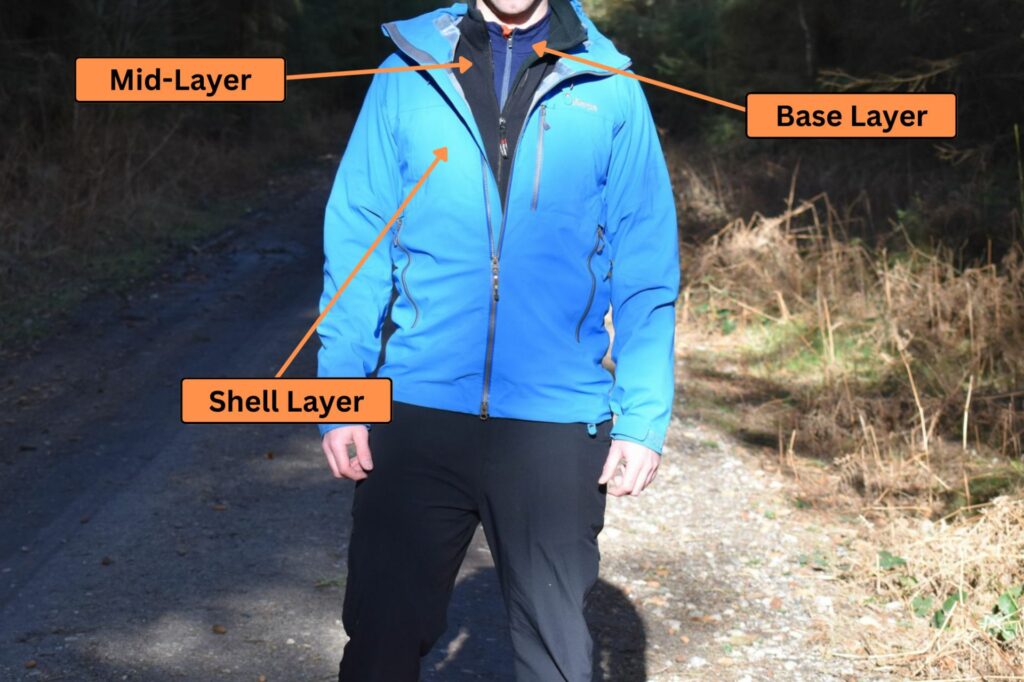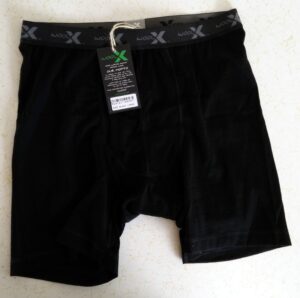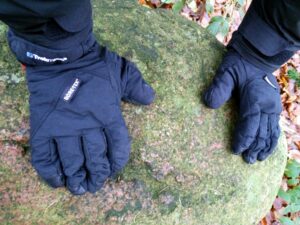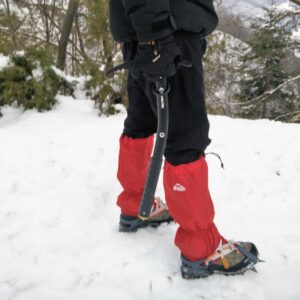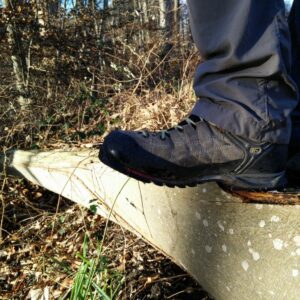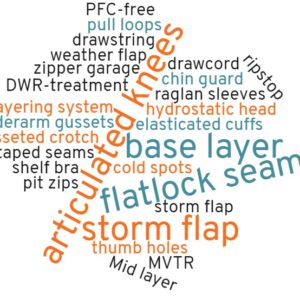Hiking requires good clothing so you are comfortable on trails, no matter the weather. Many beginners are in doubt about what garments to use and how to properly layer them. Therefore, we made this hiking clothing guide where we explain the concept of layering and give you information about different garments and how to best use them. Let’s start by explaining what is a layered garment system.
Layered Garment System
It’s important to layer your upper body clothing for aerobic activities in nature because this allows you to strip away or add garments when the weather or your activity level changes. The classic three-layer garment system consists of a base layer, insulation layer (mid-layer) and a shell layer. While a base layer is worn constantly, the insulation and shell layer are only worn if the conditions require them.
Lower body clothing is normally also layered and includes underwear and a pair of hiking pants. In very rainy weather it might be necessary to also wear waterproof/breathable overpants while you might want to use long (thermal) underwear bottoms in very cold weather. However, many hikers avoid long underwear bottoms as they can’t be put off easily (you need to first put off your boots and pants) if temperature or activity level changes. Therefore, lower body insulation is usually mainly provided by hiking pants which come in different materials for different conditions. It’s important to note that lower body insulation is not as vital as proper insulation of the upper body – simply because the human body loses much less heat in the lower part than it does in the upper part.
In the following you will find detailed information about the layered garment system for the upper and lower body respectively as well as the different types of garments that are used for hiking.
Jump to:
Upper Body Clothing
Base Layer
Worn: Next to the skin
When: Constantly
Primary function: Wicks humidity away from the skin
Common materials: Polyester, Merino wool
A base layer is a garment that is worn next to the skin, with or without other layers on top of it depending on the weather. Base layer garments include t-shirts, long-sleeved shirts, tank tops etc. The main function of these garments is to wick away humidity (perspiration) to the outer layers so that you stay dry. In cold weather it’s especially crucial to stay dry as humid/wet skin and clothing result in rapid body heat loss. This is due to the fact that the thermal conductivity of water is 25 times higher than the thermal conductivity of air, meaning that it transfers heat much faster.
In addition to managing moisture a base layer should also protect your skin against UV rays and chafing from backpack. As it is worn directly against your skin, it should be made of material that is soft to the touch and odor-resistant.
Base layers vary in sleeve length, fit and materials.
Base Layer Materials
The most common materials for base layers for hiking are polyester and Merino wool. Nevertheless, a base layer can also be made of nylon, silk or cotton. Cotton base layers are, however, not recommended for aerobic activities such as hiking as they absorb too much moisture and thus can’t keep you warm. Below you will find a brief description of the two most common materials used in base layers (polyester and Merino wool). For an in-depth analysis of all base layer materials, check our article Comparison of Base Layer Materials.
Polyester
Polyester is the most commonly used material for base layer clothing. It is very light, absorbs very little moisture in its own weight (up to 0.4%), dries very fast and efficiently wicks moisture away from the skin. However, polyester has poor odor-resistance (even if treated with antimicrobial agents – which will anyway be washed out eventually) and usually offers only mediocre breathability.
- Pros: Inexpensive, quick drying, moisture-wicking, durable, lightweight
- Cons: Odor resistance, synthetic feel, breathability
Merino wool
Merino wool is increasingly popular in the outdoor clothing industry as it offers great comfort (it is very soft to the touch), natural odor-resistance (due to anti-microbial properties of the wool), breathability and unlike other fabrics it retains superb warmth even when wet. It’s important to note that Merino wool is not only suitable for cold weather as it can be knitted into very thin fabrics that will perform great also during summer days.
- Pros: Comfortable to the touch, provides warmth even when wet, naturally odor-resistant, breathability
- Cons: Expensive, dries longer than polyester, not as durable as polyester
Fit
We can divide base layers into tight-fitting base layers and loose-fitting base layers. Loose-fitting base layers are best for warm weather as the loose fit increases ventilation. Tight-fitting base layers, on the other hand, are best for cold weather as they don’t let the cold air in.
Sleeve length
Base layers with short sleeves are normally used in very warm weather (worn as a standalone garment) while in any other season, base layers with long sleeves are used so that the moisture can get transported to the outer layers more efficiently.
More about Base Layers:
- Comparison of Base Layer Materials
- Why is cotton bad for hiking?
- Why you should wear Merino wool clothing?
Mid Layer
Worn: Over a base layer
When: Moderate, cold and very cold weather
Primary function: Thermal insulation
Common materials: Polyester fleece, Merino wool, goose down, synthetic fill
Mid-layer is worn directly over a base layer when the base layer can’t provide sufficient warmth. If it’s very cold, you can wear more than one mid-layer at the same time. Mid layer garments include fleece jackets, fleece sweaters, down jackets, woollen sweaters, jackets with synthetic fill etc. The main purpose of these garments is to trap the body-warmed air within its fabric and consequently keep you warm. It’s very important that the mid layer has good warmth-to-weight ratio so that you can keep you gear weight at the minimum without sacrificing thermal comfort. In addition to having a good warmth-to-weight ratio, a mid layer should also be quick drying, moisture-wicking and well-packable (so that it doesn’t take up too much space in your backpack). Mid layers are normally rather tight-fitting in order to increase the thermal efficiency.
Mid layer garments differ by materials and design (zippered jacket, pullover, hooded jacket etc.).
Mid Layer Materials
Mid layers for hiking are ordinarily made of polyester fleece, Merino wool, goose down (only insulation) or synthetic fill (only insulation). Below is a brief description of these materials. For a thorough description of mid layer materials, read our article Comparison of Mid Layer Materials.
Polyester fleece
Polyester fleece is the synthetic material of choice when it comes to mid layers. It is inexpensive, absorbs very little moisture, dries fast and efficiently transports moisture from the base layer to the outer layer. However, polyester fleece does not have as good a warmth-to-weight ratio as down or synthetic fill. It is also less compressible.
- Pros: Inexpensive, moisture-wicking, quick-drying, durable, retains decent warmth even when wet
- Cons: Less compressible than down or synthetic fill, inferior warmth-to-weight ratio in comparison to down or synthetic fill
Merino wool
Merino wool is seldom used when it comes to mid layers for hiking as it is less thermally efficient (has a lower warmth-to-weight ratio) and more expensive than polyester fleece. It also takes longer to dry, absorbs more moisture and has mediocre durability.
- Pros: Retains warmth even when wet
- Cons: Inferior warmth-to-weight ratio in comparison to polyester fleece, less compressible than polyester fleece, expensive, dries longer than polyester fleece, less durable than polyester fleece
Goose down
Goose down is one of the best insulators as it consists of fluffy clusters that can trap large amounts of body-warmed air. It offers a superior warmth-to-weight ratio and is more compressible than any other insulation material used in the clothing industry. However, goose down gets flat when exposed to moisture/water and thus loses its ability to provide warmth. Therefore, clothing that uses down insulation can be used efficiently only in dry conditions.
- Pros: Warmth-to-weight ratio, compressible
- Cons: Loses its warmth when wet, expensive
Synthetic fill
Synthetic fill generally offers a better warmth-to-weight ratio than polyester fleece but not as good as goose down. It also doesn’t compress as good as goose down.
- Pros: Less expensive than goose down, retains decent warmth even when wet
- Cons: Less thermally efficient than goose down, less compressible than goose down
Design
Zippered jackets are the most versatile because they allow you to easily regulate your upper body temperature – you can simply unzip the jacket if you get too warm. However, mid-layer garments also come as pullovers which are in general more durable than zippered jackets as there is no zipper that could cause problems in the long run. When deciding for a mid-layer with or without a hood, you need to consider how much you would actually use the hood. A bulky hood might get in the way when wearing the garment under a shell layer. Mid-layer garments ordinarily come with very thin hoods that offer a tight fit (“scuba hood”) for maximum insulation.
More about Mid Layers:
Shell Layer
Worn: Over a mid layer or directly over a base layer (in warm weather)
When: Normally only in windy and/or rainy weather
Primary function: Protection from the elements (rain, wind)
Common materials: Gore-Tex, eVent, NeoShell, Pertex Shield, Gore Windstopper, Polartec Windblock
A shell garment is worn over a base layer in mild weather and over a mid-layer in cold weather. Upper body shell layer garments include rain jackets, softshell jacket and insulated (waterproof or water-resistant) jackets. It’s important to note that a shell layer is typically worn only in windy and rainy weather because it reduces the breathability of the layered garment system to some extent. The more “waterproof” the fabric is, the less breathable it is. However, by using advanced materials manufacturers can nowadays produce fairly breathable fabrics that offer good protection against rain. Nevertheless, keep in mind that no breathable fabric is completely waterproof.
Shell layers can be divided into waterproof/breathable shells (rain jackets), water-resistant shells (softshell jackets) and insulated shells. Below is a brief description of the respective shell types. For a more thorough description of shell types, check our article Comparison of Shell Materials.
Types of Shells
Waterproof/breathable shells
Waterproof/breathable shells (also referred to as hard shells – rain jackets) offer the best protection against rain and wind. They are also very light, dry fast and can be packed very small. However, they are not as breathable as water-resistant shells are. To be “waterproof” they use membranes or coatings.
- Pros: Rain protection, wind protection, lightweight, quick-drying, well-packable
- Cons: Limited breathability, mediocre comfort (relatively stiff material)
Water-resistant shells
Water-resistant shells (also referred to as soft shells) offer less protection against rain and wind than waterproof/breathable shells, but are much more breathable and comfortable. Soft shells normally combine insulation and weather protection and thus consist of two components; a polyester fleece on the inside and a tightly woven DWR (Durable Water Repellant) treated fabric on the outside.
- Pros: Breathability, comfort
- Cons: Heavier than hard shells, dry longer than hard shells, offer only limited protection against the rain
Insulated shells
Insulated shells are water-resistant or waterproof/breathable shells that use a synthetic fill for insulation. Insulated shells are normally used for activities where superb insulation as well as weather protection is required.
- Pros: Simultaneously offer weather protection and superb insulation
- Cons: Drying time, versatility
More about Shell Layers:
- Comparison of Shell Materials
- Best 3-Layer Rain Jackets (waterproof/breathable shells)
Lower Body Clothing
Underwear (Base Layer)
Primary function: Wicks humidity away from the skin
Common materials: Polyester, Merino wool
Underwear should offer similar qualities as the upper body base layer; it should be moisture-wicking, quick-drying, breathable, comfortable against the skin and odor-resistant. Hiking underwear is normally made of polyester or Merino wool. Underwear made of cotton is not suitable for aerobic activities such as hiking as it absorbs too much moisture and thus causes chafing as well as rapid conductive heat loss. Long underwear bottoms can be used in very cold conditions but as they can’t be put off easily during the hike (you need to first put off your boots and pants), they are usually only used for around-the-camp activities after the hike. Long underwear bottoms can also be made of polyester fleece for maximum thermal efficiency. Many hikers prefer knee-length underwear in order to reduce chafing in the thighs area.
For advantages and shortcomings of different materials used in underwear, please refer to the base layer section (upper body clothing) above.
More about Underwear:
Pants
Primary function: Protection against the surroundings (rocks, vegetation etc.)
Common materials: Polyester, nylon
Pants provide protection against the surroundings (rocks, vegetation etc.) and the weather. You can use shorts in warm weather but only on well-groomed trails where protection against vegetation and terrain is not required. Hiking pants are typically made of nylon or polyester fabrics of different densities (Spandex can be included in a fabric for better stretch and freedom of movement). Nylon is the most common material for hiking pants, as it is very durable and abrasion-resistant. Polyester is less durable but on the other hand it also offers slightly better breathability and moisture-wicking performance (even though these properties also highly depend on the fabric’s thickness). The more abrasion-exposed parts on a pair of pants can be additionally reinforced with highly durable materials such as Cordura.
In cold and windy weather we recommend wearing thicker pants made of tightly woven nylon (softshell) for better insulation and protection against the wind. In heavy rain you will need waterproof/breathable pants (hardshell). These pants are typically worn over ordinary hiking pants.
More about Pants:
Accessories
Socks
Primary function: Wicks humidity away from the skin, cushioning and insulation
Common materials: Nylon, polyester, Merino wool
The main purpose of socks is to transport moisture from the feet to the boots’ lining as moist/wet feet get cold very fast. Furthermore, moist/wet feet also result in increased friction and thus cause blisters. Therefore, socks have to be moisture-wicking, quick-drying and breathable. They also have to provide minor cushioning and insulation for good comfort.
Socks Materials
Hiking socks are normally made of a mix of fibers with different densities. They can be divided into those that mainly contain Merino wool fibers and those that mainly contain synthetic fibers. Socks do provide some insulation and therefore thick socks are recommended for cold weather while thinner socks are recommended for warm weather. Socks made of cotton are not suitable for hiking as they absorb too much moisture and thus cause blisters (due to increased friction) as well as conductive heat loss.
Merino wool socks
So-called Merino wool socks are never made exclusively of Merino wool fibers as these are simply not durable and stretchy enough. Instead Merino wool fibers are usually mixed with nylon (for durability) and spandex (for stretch). Merino wool fibers can, however, form as much as 70% of the fabric. Socks with a high content of Merino wool fibers offer good breathability, provide warmth even when wet and are naturally antimicrobial. They are, however, more expensive than synthetic socks.
- Pros: Provide warmth even when wet, naturally antimicrobial, moisture-wicking, breathable
- Cons: Less durable than synthetic socks, dry slower than synthetic socks, more expensive than synthetic socks
Synthetic socks
Socks made strictly of synthetic fibers (nylon, polyester, spandex etc.) are more durable than Merino wool socks and also dry faster. However, synthetic socks do not retain warmth when wet and are not naturally antimicrobial.
- Pros: Durable, quick-drying, moisture-wicking, inexpensive
- Cons: Do not provide warmth when wet, poor odor resistance
Headwear
Primary function: Thermal insulation
Common materials: Polyester fleece, Merino wool
In cold weather a hat comes in handy because it provides insulation and significantly reduces the body heat loss. Studies claim that 10% of all body heat is lost from the head. Hiking hats are normally made of Merino wool or polyester fleece. Polyester fleece has a better thermal efficiency (warmth-to-weight ratio) than the Merino wool. Therefore, hats made of polyester fleece are normally worn in cold and very cold conditions while Merino wool hats are typically worn in more moderate conditions.
For a comparison of Merino wool and polyester fleece, please refer to the mid layer section above where their respective advantages and shortcomings are described.
In summer a baseball cap, boonie hat or bandana can be worn for protection against the sun.
More about Hats:
- Comparison of Mid Layer Materials (in-depth information about polyester fleece and Merino wool)
Gloves
Primary function: Thermal insulation
Common materials: Polyester fleece, Merino wool, synthetic fill, waterproof/breathable materials
Fingers are one of the body parts most prone to frostbite and thus it’s essential to protect them from cold. When it comes to hiking handwear there are two approaches – “all-in-one gloves” and layered handwear (more than one pair of gloves is worn at the same time).
All-in-one gloves are usually relatively thick and provide insulation as well as protection against the elements (rain, wind). However, all-in-one gloves offer very limited functionality as they do not keep your hands at a comfortable temperature when the weather or activity level changes. Therefore, many hikers prefer to wear several pairs of thinner gloves where each pair has a specific function.
Layered handwear is layered in a similar way like the upper body clothing – the first layer (liner gloves) transports perspiration to the outside, the second layer (fleece gloves or gloves with synthetic fill) provides insulation and the third layer (waterproof/breathable mittens) is a shell which offers protection against the elements (wind, rain). This system enables your hands to feel comfortable, even when the activity level or weather changes. You only add the second and third layer if the conditions require them. However, going with this system is much more expensive because you basically need three different pairs of gloves.
